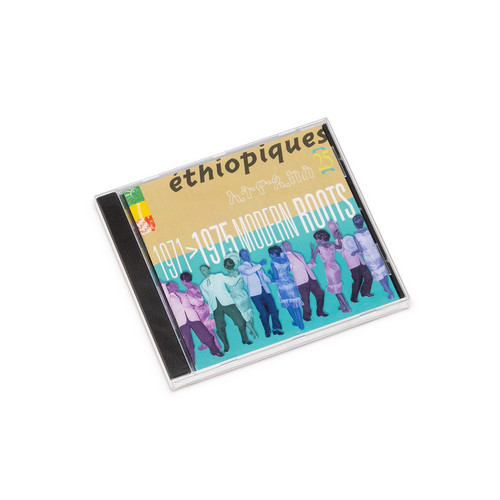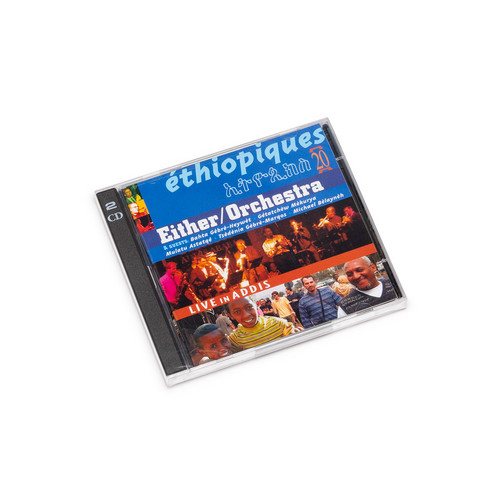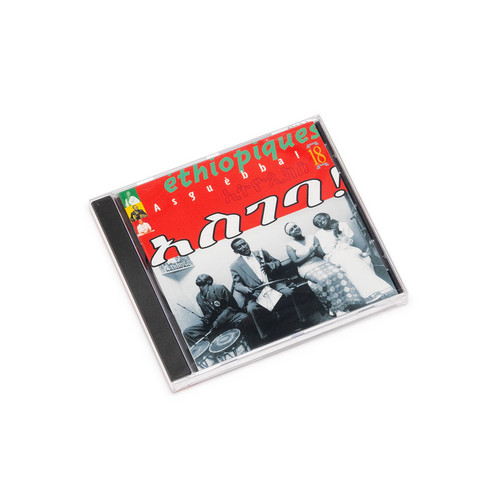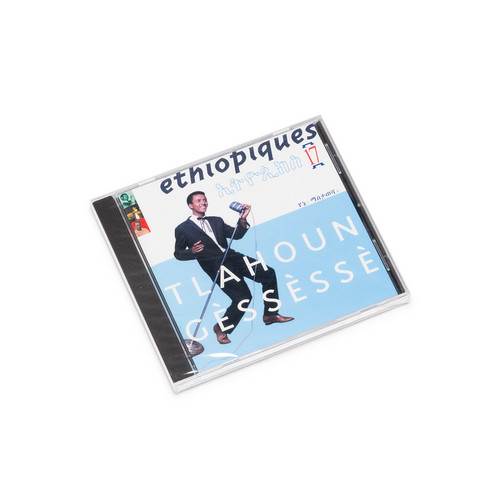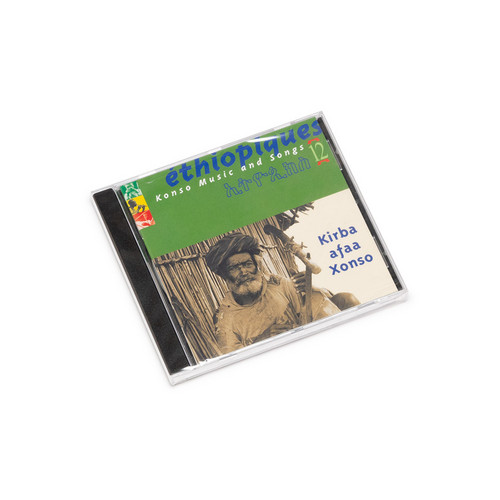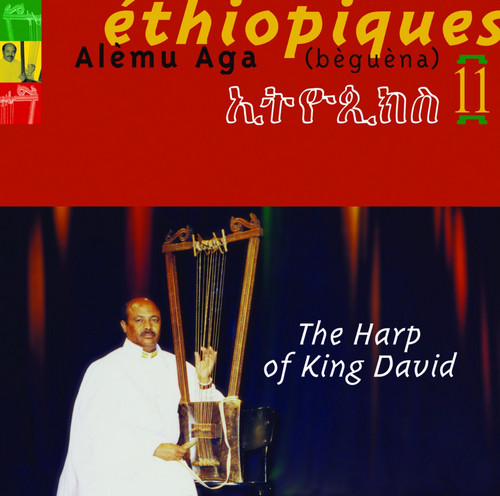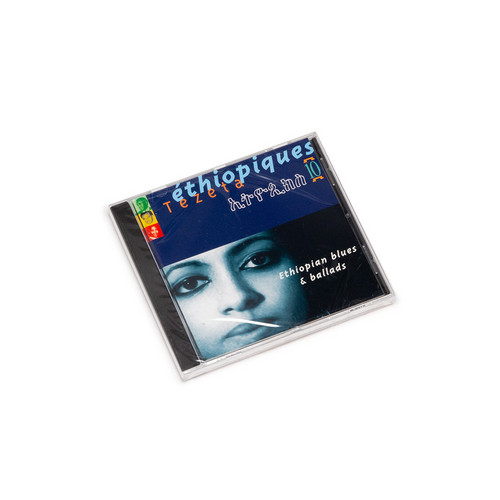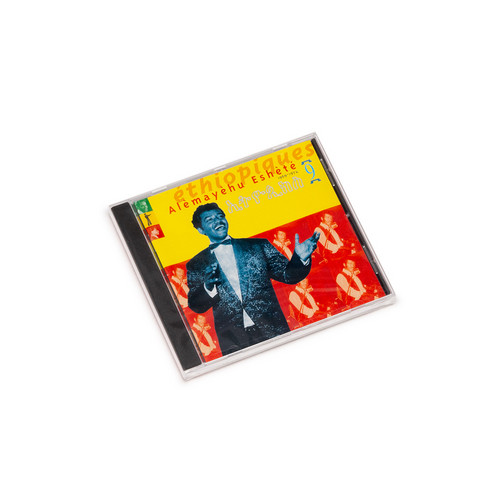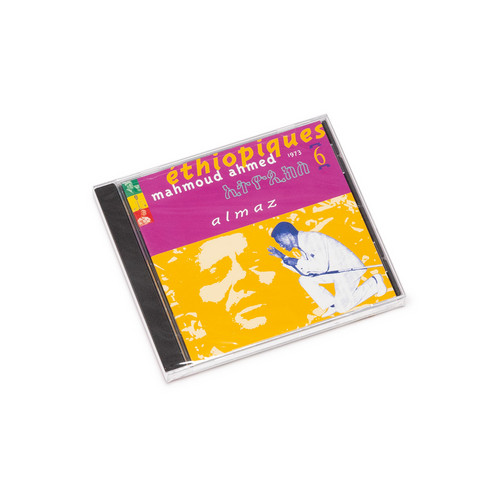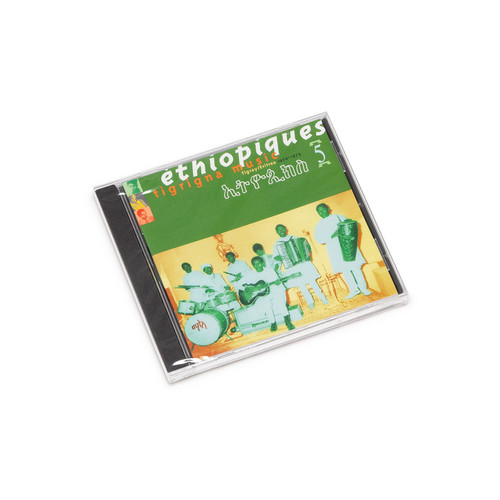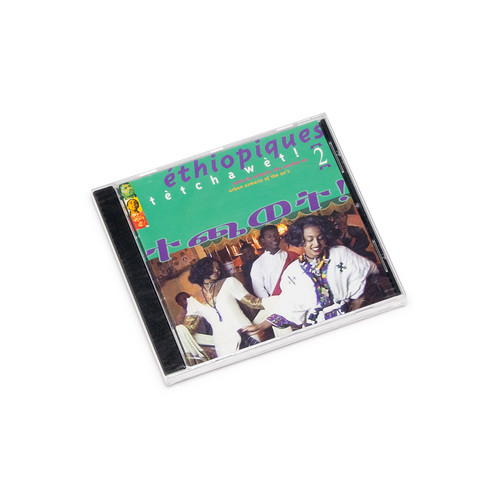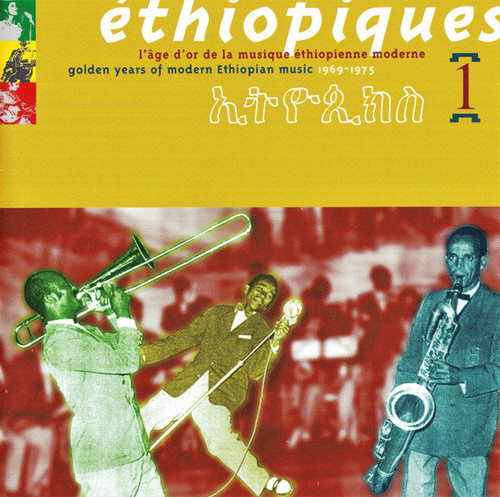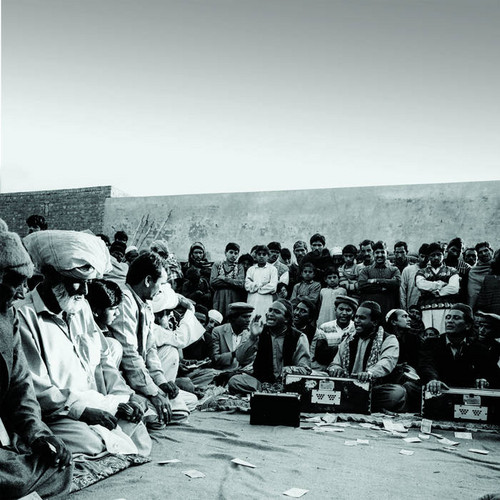Folk /
Éthiopiques 25: 1971-1975 Modern Roots
*2024 stock* The Swinging Addis of the 1960s and early 1970s (before the dreadful Derg’s Stalinist-military glaciation) was a period of intense experimenting that encompassed the traditional repertoire. Whether Oromo or Amhara, all the greatest voices of the time took part with intense creative fervour, as can be heard on this 25th CD in the Ethiopiques collection. It features such pop singers as Tlahoun Gèssèssè, Alèmayèhu Eshèté, Sèyfou Yohannes, Essatu Tèssèmma etc. as well as traditional art…
Éthiopiques 24: Golden Years Of Modern Ethiopian Music 1969-1975
*2024 stock* As was the case with Ethiopiques 1 and 3, this 24th CD in the Ethiopiques collection presents a selection of powerful pieces from the historical Amha Records catalogue. We meet again with such artists as Ayaléw Mèsfin, Gétatchèw Kassa and Sèyfou Yohannes, and are introduced to other artists as yet unreleased or hardly known in the West, among them Menelik Wèsnatchèw, Seyoum Gèbrèyès, Tamrat Molla and Wubshèt Fisseha. Bonus tracks: Two pieces by the young Mulatu Astatqé, recorded in …
Éthiopiques 23
*2024 stock* The story of Orchestra Ethiopia (1963-1975) is unusual and compelling in more ways than one. Just as modern music was reaching the peak of its excellence and popularity, at the very same moment, via Orchestra Ethiopia's unlikely undertaking, traditional music acquired a legitimacy that the times had tended to deprive it of. Between the coup d'état (Dec 1960) and the revolution (1974), Ethiopia was combining, unbeknownst to all, both the end of an empire and the "golden age" of its m…
Éthiopiques 22: More Vintage! 1972-1974
*2024 stock* Alèmayèhu Eshèté is no less than one of the great voices of the heyday of modern Ethiopian music -- the Swinging Sixties which, in Ethiopia, went on until the fall of the Emperor Haile Sellassie I in 1974. On a par with Tlahoun Gèssèssè, Bzunèsh Bèqèlè or Mahmoud Ahmed, Alèmayèhu is a star at the top of the constellation that once lit up the wild nights in the capital city Addis Ababa. The singer, as remarkable for his frenetic rock numbers as for his heart-rending ballads, has, by …
Éthiopiques 20: Live In Addis
*2024 stock* Russ Gershon and his Grammy-nominated Either/Orchestra have included many Ethiopian pieces into their repertoire in recent years. In January 2004, the Boston big band travelled to Addis for a dream-come-true concert featuring prestigious Ethiopian guests, among them Mulatu Astatqè (Ethiopiques 4, «Broken Flowers») and Gétatchèw Mekurya (Ethiopiques 14). This recording perfectly renders the energy and emotion of this gathering, with beautiful arrangements remarkably performed by exce…
Éthiopiques 19: Alèmyé
*2024 stock* «An authentic legend in Ethiopia, Mahmoud Ahmed has laid down the basis of a music style which is resolutely original in the way it synthesizes the most diverse influences into a language both typical and universal. With his haunting, serpentine voice, at the same time raucous and velvety, Mahmoud Ahmed has invented a world of uncertain borders, an improbable mix of Eastern-African rhythmic lines, mysterious laments with refined ornamentation and melodies of unexpected Indian modula…
Éthiopiques 18: Asguèbba!
*2024 stock* «Asguèbba!» is the Azmari’s cry urging listeners to enter into the dance, an invitation carrying the same sexual innuendo as Latino’s ¡Va dentro! The recordings on this CD are intended as a continuation of those in Tètchawèt! (Ethiopiques 2) and feature most of the artists from the first edition.The songs are accompanied on the mèessenqo (one string fiddle), the krar lyre, the kebero drum and the accordion.
Éthiopiques 17: Tlahoun Gèssèssè
*2024 stock* To Ethiopian audiences, Tlahoun Gèssèssè is THE VOICE, even more so than Mahmoud Ahmed, Alèmayèhu Eshèté or Mulatu Astatqé. Endowed with a phenomenal, innate vocal talent, he has been the asbsolute and unequalled icon for an entire country since the fifties, heading up the list of Ethiopian discography. Based around seven ‘modernist’ pieces arranged by the brilliant and innovative Mulatu Astatqé (Ethiopiques 4 : «Ethiojazz»), these first Ethiopiques devoted to Talhoun Gèssèssè also …
Éthiopiques 16: The Lady With The Krar
*2024 stock* Before she became famous as a singer and a player of the krar –the traditional Ethiopian lyre– Asnatqèch Wèrqu was well-known as an actress and a dancer. Inspired by the art of the 'azmaris', the Ethiopian wandering minstrels, she found the voice to transform the vicissitudes of life into poignant laments or sarcastic ditties. Asnatqèch is the last great singer, story-teler and free-thinker to carry on the tradition of "poetic jousting". Needless to say, the CD booklet features the …
Éthiopiques 15: Europe Meets Ethiopia
*2024 stock* The result of a surprising encounter between Ethiopian, French and Dutch musicians, Jump to Addis presents a buoying mix of Abbyssinian tradition, revisited jazz and wild rock'n'roll. The krars (folk lyres) and voices of urban azmaris rub shoulders with the guitars, saxophones and drumsets of European musicians, all in an audacious blend.
Éthiopiques 12: Konso Music And Songs - Kirba Afaa Xonso
*2024 stock* The Ethiopiques series aims to make Westerners discover the missing link in African music. The great Italian musicologist Enrico Castelli has devoted this recording to the Konso, an ethnic group living at the border with Sudan. This panorama of Konso music presents pieces linked to daily agricultural tasks, sacred and ritual songs, as well as recreational songs. The rich instrumentarium includes "hibhara", "maayra" and "luutota" flutes, "kihayta" lyre to accompany songs, "tawna" be…
Éthiopiques 11: The Harp Of King David
*2024 stock* Although commonly know as "King David's harp", the bèguèna is not actually a member of the harp family. It is in fact an oversized lyre with ten strings –usually plucked, sometimes strummed with a plectrum. It is probably the oldest musical instrument played in Ethiopia. One of today's uncontested masters of the bèguèna, Alèmu Aga, sings religious songs, traditional fables and folk tales, as well as his own poems. Meditative, devotional or uplifting sor some, simply "mind blowing" f…
Éthiopiques 10: Tezeta - Ethiopian Blues & Ballads
*2024 stock* Emptiness, melancholy, nostalgia; doom and gloom, morbid musings; heartache or homesickness: such is the stock in trade of the misery and mournful memories expressed by the song Tezeta - Ethiopia's majestic hymn to the blues. Etymologically, the word itself means memory, nostalgia, and several Ethiopian authors have used Tezeta as the title for their memoirs. For Ethiopians, it is the Tezeta genre that seems to capture the essence of the blues.
Éthiopiques 9 (1969-1974)
*2024 stock* The Alèmayèhu songs already presented in Ethiopiques 3 and 8 have given a foretaste of this outstanding stylist of Ethiopian pop, a singer as remarkable for his frenetic rock numbers as for his heartrending ballads. By dint of rampant Americanism, he earned himsef such nicknames as The Ethiopian James Brown or the Abyssinian Elvis. With his dazzling stage presence, nimble voicebox and wicked pompadour, he is a strutting show-off, straight out of American Graffiti or Saturday Night F…
Éthiopiques 6: Almaz
*2024 stock* For many years everything we knew about Mahmoud Ahmed (and Ethiopian music in general) was limited to the cult album Erè Mèla Mèla (Ethiopiques 7 CD 829802), recorded in 1975 but released for the first time in Europe in 1986. Mahmoud's first LP, Almas ("Almaz men eda nèw"), recorded two years before Erè Mèla Mèla, now bears new witness to the talent of one of the greatest Ethiopian artists of the past 35 years.
Éthiopiques 5: Tigrigna Music (Tigra / Eritrea 1970-1975)
*2024 stock* "Tigrigna music" refers to music of Tigray and Eritrea. The majorities in each of these territories share the same language, Tigrigna. Tigrigna music, dominant in Tigray and Eritrea, is quite distinct, both rhythmically and melodically, from 'Ethiopian' music, though both share the pentatonic scale. However, the instrument and traditional musical practices are similar, while their names may vary. Aside from the Tigrean Bèzuayènè Zègèyè, most of the artists featured on this album are…
Éthiopiques 3: Golden Years Of Modern Ethiopian Music 1969-1975
*2024 stock* The Amha Records label issued approx 250 tracks in six years (1969-1975). 8 songs on this "Ethiopiques 3" CD are accompanied by bands affiliated with the Police. Indeed, until the very end of the 1960s, Ethiopia had no independant modern bands. Musical life was wholly dominated by the institutional bands attachd to either the Imperial Body Guard, the Police, the Army, the ciry of Addis Ababa, Agher Feqer Mahber or the Hayle Sellasie Theatre. Each of these institutions developed seve…
Éthiopiques 2: Tetchawet!
*2024 stock* Originally wandering minstrels, sharp-tongued peddlers who roamed the old Abyssinian countryside, many azmaris more or less settled down after the founding of Addis-Ababa just over a century ago. The cleverest of them quickly understood that they should set up their own businesses and take a cut on the drinks, instead of getting by on tips earned singing their way from one bar and tedjbèt (taverns serving tedj, the local mead) to another. (…) They have taken over the city by giving …
Éthiopiques 1 - Golden Years Of Modern Ethiopian Music 1969-1975
*2024 stock* 1969-1978. The main body of Ethiopian records was produced in less than one decade: all in all, just under 500 45s and around 30 LP albums. Amha Eshèté, creator of the Amha Records Label, was the driving force behind this brief creative burst and one of the main founders of the modernist movement, which swept the Ethiopian scene during the end of the rule of the Emperor Haile Sellassie. In six years (1969-1975), Amha issued approx 250 tracks. From his first recordings, he dispayed a…
Qawwali, The Essence Of Desire
Big Tip! *2024 stock* Qawwali is a syncretic musical form of heterodox Islam (the unorthodox doctrines of the Sufis, a group of ascetics and mystics) in South Asia. Derived from the Arabic Qaul (to say, creed, word), the term designates both an Indian and Pakistani musical genre and its manifestation. A religious song designed to convey the message of Sufi poetry, Qawwali is performed by an ensemble of professional male musicians (the Qawwal) ranging from 3 to 13 people.
